Ultimate Composite Decking Guide: Durable Choices for 2024
Reading Time: 14 minutesChoosing the right decking material is crucial for any home improvement project. Composite decking is a standout choice that blends durability, low maintenance, and various designs. This comprehensive guide will delve into everything you need to know about composite decking, compare it with traditional wood, detail maintenance savings, and showcase leading brands to help you decide if it’s the right choice for your deck in 2024.

Let’s be honest; we want additional outdoor space for relaxation, picnics, parties, and BBQs. Decking, which you install at ground level on the veranda, patio, flat roof, or balcony, will provide that space. We will discuss the main types of decking and the advantages of one of the most popular technologies: composite decking.
Key Takeaways
- Composite decking is a low-maintenance, durable, and eco-friendly alternative to traditional wood, offering a hassle-free solution that saves time and money in the long run.
- Leading brands like Trex, TimberTech, Fiberon, and MoistureShield offer a range of composite decking options with advanced features like slip resistance, heat-mitigating technology, and various colors and patterns to enhance outdoor living spaces.
- Despite higher initial costs, composite decking proves cost-effective over time. It has reduced maintenance costs, and online calculators can compare long-term investments against traditional wood decking.
Why Choose Composite Decking?
When it comes to decking, the choice between traditional wood and composite can be tough. But as you’ll discover, composite decks offer many advantages over their wooden counterparts.
Imagine a world where your deck remains unfazed by the weather, resists fading and staining, and stays looking fresh and new for years on end. Welcome to the world of composite decking!
Low Maintenance
One of the standout features of composite decking is its low maintenance. Imagine a deck that doesn’t demand constant sanding, staining, or sealing, freeing up your time for more enjoyable pursuits. With composite decking, you’re not just investing in a product; you’re buying back your weekends.
The occasional clean is all it takes to keep your composite deck looking pristine, translating into considerable long-term cost savings.

Durability and Longevity
Composite decking isn’t just about ease of maintenance; it’s also incredibly durable and long-lasting. Engineered to resist common problems such as fading, staining, and scratching, composite decks do not crack, rot, or warp. This durability extends the lifespan of your deck, reducing the frequency of replacements and making it a truly sustainable option in the long term.
Aesthetics and Design Flexibility
Composite decking is more than just a practical choice; it’s a visually appealing one as well. Offering a variety of natural hues and patterns, composite decks are designed to emulate the authentic look of wood. Each board is unique, boasting variations in grain patterns and subtle color blending, providing a unique, more natural wood feel for each deck.
And with free or low-cost samples readily available, you can personally evaluate the textures and colors before making a decision.
Composite Decking VS Natural Wood and PVC
Let’s begin with the weak sides of other solutions available in the production of decking boards. For example, natural wood looks very elegant, but boards can start to rot or change shape over time. In addition, almost any wood surface must be seasonally maintained and covered with wax, paint, and various chemical impregnations.
PVC decking is a good alternative to natural wood, but PVC material is completely synthetic (it may look like wood, but this technology has its cons). In addition, PVC boards are not the most affordable option on the market.
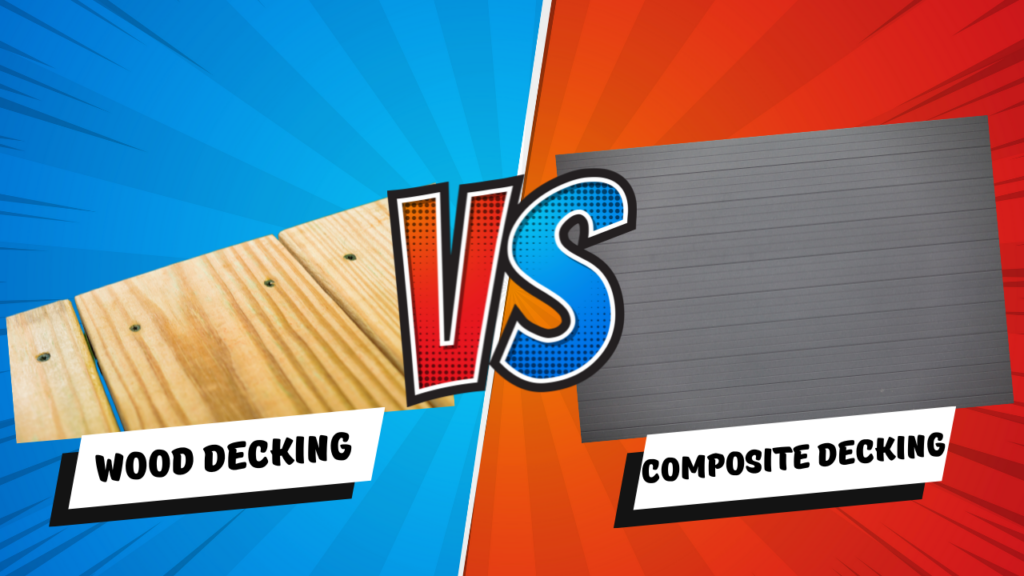
Composite materials comprise 50 percent wood products and 50 percent synthetic materials (recycled materials, color tints, and bonding elements). The ratio of natural and synthetic raw materials may vary depending on the technology used by the composite decking manufacturer.
Thus, thanks to this technology, it was possible to create a practical, relatively inexpensive, and environmentally friendly material that is used, among other things, to produce high-quality decking boards.
Materials Used in Composite Decking
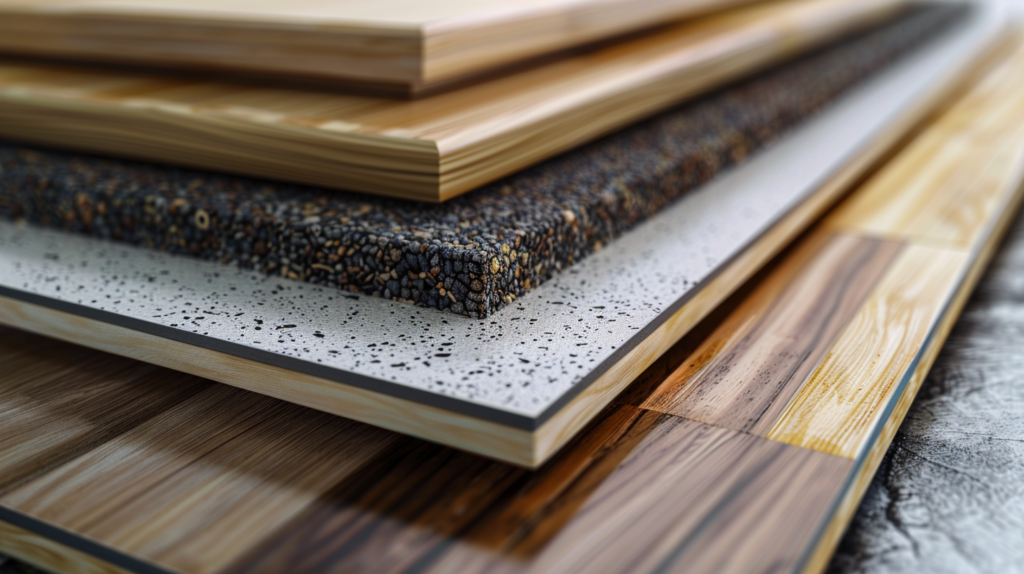
Is composite decking, also known as composite boards, a unique blend of wood particles and plastic components, often sourced from recycled content? This carefully engineered combination results in the best composite decking that is not just aesthetically pleasing but also highly durable and resistant to adverse weather conditions. With a wide range of composite decking products available, homeowners can easily find the perfect option to suit their needs, including PVC decking and the most composite decking, and install composite decking in their outdoor spaces.
The use of recycled plastics and reclaimed wood fibers in the manufacturing process underscores the eco-friendly nature of composite decking.
Recycled Plastics
The use of recycled plastics in manufacturing composite decking makes it a truly green choice. Some examples of post-consumer waste that find a new life in composite decking include:
- Grocery bags
- Shampoo bottles
- Milk jugs
- Water bottles
By using these recycled materials, composite decking helps to reduce landfill waste and promote sustainability.
The recycling process ensures these recycled plastic film materials meet quality standards for decking material, providing another layer of quality assurance for composite decking customers.
Reclaimed Wood
Wood fibers, including ‘wood flour’, are incorporated into composite decking to achieve a natural-looking texture and appearance. This not only enhances the aesthetic appeal of your own decking boards but also contributes to the eco-friendly nature of composite decking by repurposing wood that might otherwise go to waste.
Synthetic Materials
Synthetic materials, such as polypropylene and hardwood composite, are used in the production of composite decking for enhanced performance and longevity. These materials are combined and shaped into deck boards through processes like extrusion or compression molding.
The end result is a decking material that is highly durable and resistant to the elements, ensuring your deck remains beautiful and functional for years to come.
The Main Advantages of Composite Decking Boards
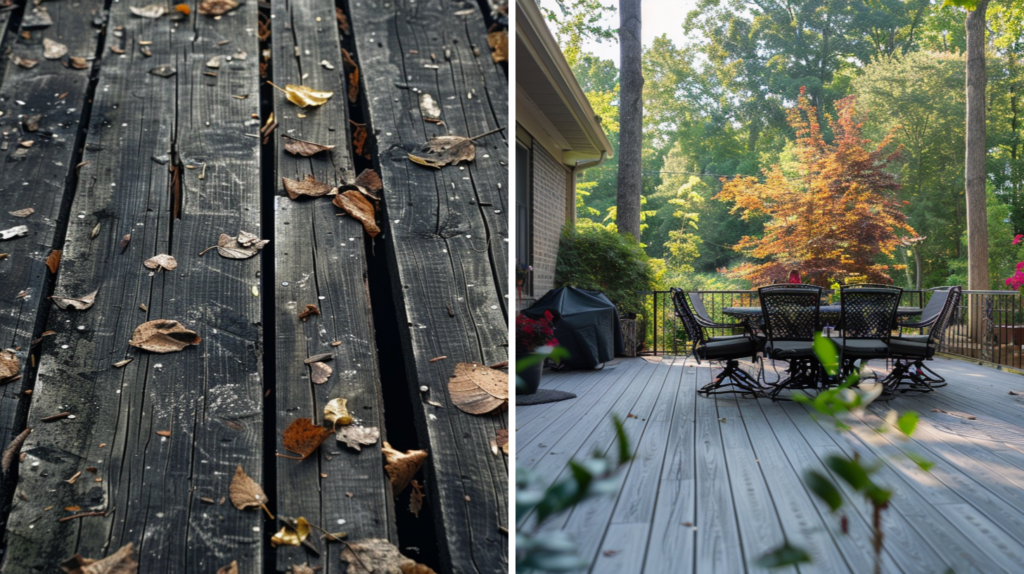
What are the main benefits of material for a floor surface located on the roof, balcony, or garden?
- Service life is 30+ years. You probably don’t want to change boards every 10 years. The service life of composite materials can be even longer than 50 years. Your children and grandchildren will use the boards if you choose high-quality material.
- Since the composite decks are used outdoors, they are immune to climatic conditions, Boston winters, and summers. Properly installed decks are unafraid of temperature changes, winter frost, and hot summer weather.
- Unlike natural wood and PVC, composite materials practically do not fade and stain under UV rays. It means that even after 10-15 years, your terrace will look the same as on the first day after installation. On average, some manufacturers give a 25-year warranty on their product.
- Nevertheless, composite boards absorb little moisture and do not rot or warp. For Boston, this is the most practical and durable deck-covering option.
- If you have neighbors with wooden decks, you have probably heard from them about the problems with bent or cracked boards. Every square foot of composite decking materials remains geometrically stable and does not crack or chip. Composite decks are easy to install, even with hidden fasteners.
- This material is an excellent alternative to wood because it does not require special or every-month care. It is easy to clean and wash. Unlike real wood, composite decks need not be waxed or repainted every season.
- The surface of composite deck boards is comfortable to walk on. The surface is stain/scratch resistant and does not wear off over time. If necessary, you can choose anti-slip boards.
How to Choose Composite Decking Boards: Dennis Tchernov Advice

As mentioned above, the ratio of natural and synthetic raw materials and connecting components in composite materials can differ. We recommend choosing materials that contain at least 40% wood-based materials.
Be sure that the chosen products are certified and that all substances in the composition are non-toxic and safe for contact with people and pets.
There are dozens of brands and hundreds of composite decking offers on the US and Massachusetts markets. To save you time, let’s talk about the basic distinguishing criteria for these materials:
There are three main categories of composite deck boards based on production features:
- Solid. The structure of these boards is monolithic. Such boards weigh more than other types of composite decks, but they are very durable. As a rule, they are mounted where many people walk daily – in hotels, restaurants, and public pools. However, if you want the most durable option, solid decks can be chosen for flat roof terraces in private houses or ground-level decks.
- Hollow or blank. This type of material has an open structure. Such boards weigh less and are easier to mount but are not designed for increased loads. Sometimes, they are used as a terraced floor covering and for wall decoration.
- Capped composite decking materials are universal – such coatings can be used near pools, in rooms with high humidity, on flat roofs, etc. Their distinguishing feature is a two-level structure, internal and external. The inner material comprises natural wood and polymer particles, and the outer layer comprises a synthetic protective coating. The result is a wear-resistant and durable material that does not weigh too much.
The second important aspect is color. Remember that composite boards cannot be repainted, so the shade and texture should match the building’s exterior and architectural style. Fortunately, manufacturers offer various product lines, colors, and textures, from natural wood grain imitation to exclusive jet black, silver, or bright white variations.
Please note: not all composite materials are resistant to mold or fading. Choose special products if you will use the material outdoors or in places of high humidity.
Installation Tips for Composite Decks
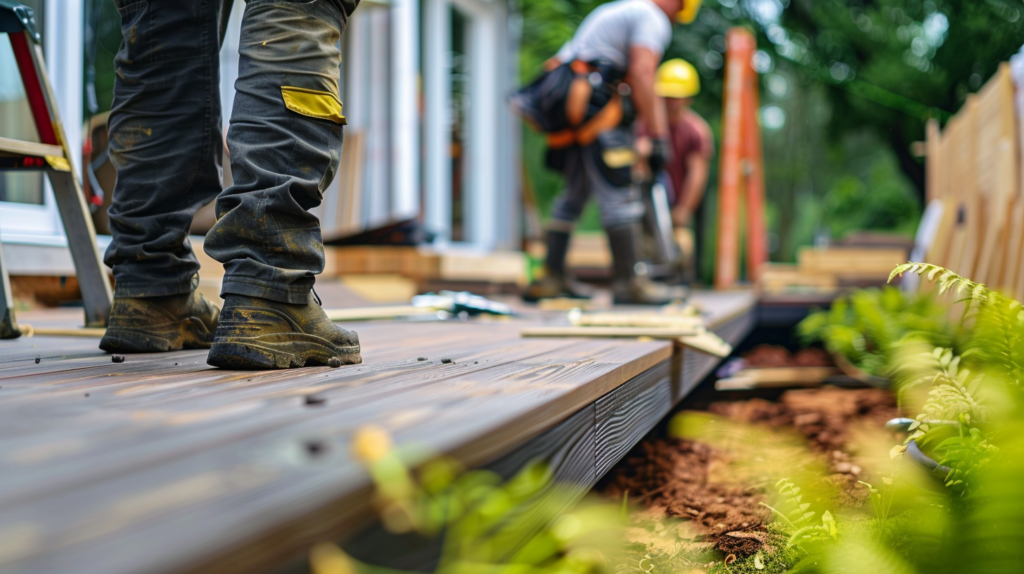
Installing a composite deck follows similar guidelines to wood decking. Whether you’re a DIY enthusiast or prefer to hire a professional, understanding the installation process can help ensure your deck is installed properly and lasts for years. From choosing the right fasteners to determining the correct spacing, these tips will help you navigate the installation process with ease.
Grooved Edge Boards
Grooved edge composite deck boards offer a sleek, seamless look for your deck. These top deck boards are installed using starter clips and hidden fasteners, resulting in a clean, fastener-free surface.
The final board is secured by pre-drilling an oversized pilot hole at an angle and screwing the board directly into the joist. This method ensures secure attachment and a clean finish.
Spacing Considerations
When installing composite decking, proper spacing is crucial. Here are some guidelines to follow:
- Composite decking materials typically require a minimum joist spacing of 16 inches on-center for straight decking.
- However, for diagonal decking or to enhance the structural integrity of the deck, you may need to reduce the joist spacing to 12 inches on-center.
- Always check brand-specific requirements to ensure proper installation.
DIY Enthusiasts vs. Professional Installation
The choice between DIY and professional installation for composite decking depends on your building expertise, the complexity of the project, and the need to adhere to warranty stipulations. Opting for DIY installation can result in substantial savings on labor and overhead costs, and allows you to dictate design details and work at your own pace.
However, hiring a professional ensures your deck is installed correctly, potentially saving you time and hassle in the long run.
Unleash Your Creativity: Exciting Decking Stories
Leading Composite Decking Brands for 2024
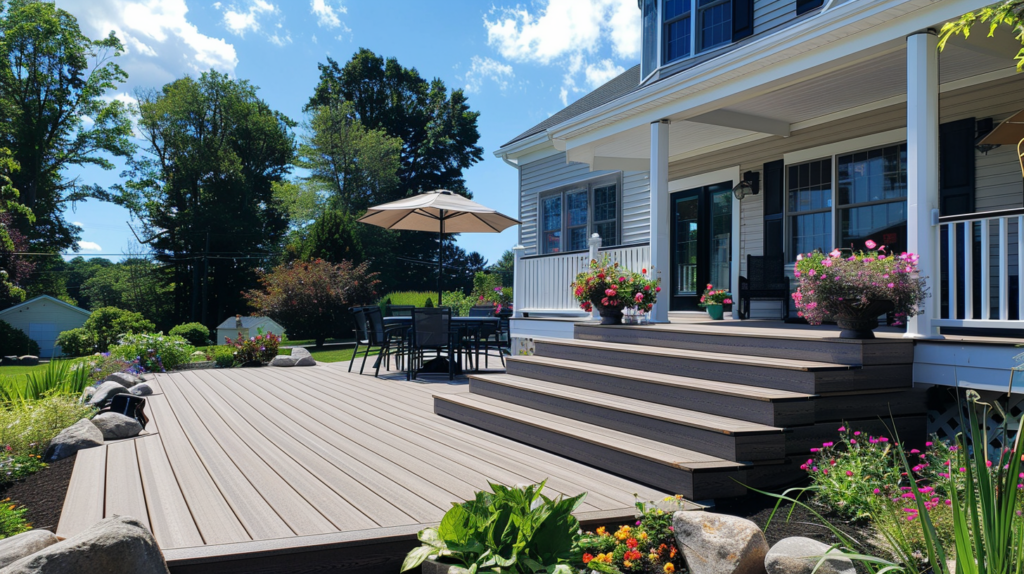
The composite decking market is brimming with the best brands, each offering its unique blend of features and benefits. From extensive warranties and innovative designs to eco-friendly manufacturing processes, these top brands are setting the bar high for the industry in 2024.
Let’s delve into some of the leading brands and what makes so many brands stand out.
Trex Composite Decking
Trex stands out as a leading brand in the composite decking market, offering a range of high-performance, eco-friendly options. Some key features of Trex is composite decking, include:
- Crafted from up to 95% recycled plastic films and reclaimed wood
- Durable and long-lasting
- Visually appealing
- Environmentally friendly
With options to suit every taste and budget, Trex offers customization like no other.
TimberTech
TimberTech’s composite decking options are a perfect blend of beauty and functionality. With an unwavering focus on fine details and natural aesthetics, TimberTech offers a range of sustainable, low-maintenance decking solutions that closely mimic the look and feel of real wood.
Whether you’re looking for durability or design flexibility, TimberTech has got you covered.
Fiberon
If you’re looking for a variety of colors, textures, and innovative features, Fiberon is the brand for you. With its eco-friendly approach to manufacturing and its commitment to using up to 85% recycled materials, Fiberon sets a high standard for composite decking.
Not to mention, the brand’s commitment to reducing water waste during manufacturing makes them a standout player in the industry.
MoistureShield
For those seeking a deck that can withstand wet environments, MoistureShield is the brand to consider. Their composite decking is equipped with CoolDeck Technology, reducing heat and moisture absorption, and providing a cooler deck surface even on hot days.
MoistureShield’s products are suitable for use around pools and in marine environments, showcasing the brand’s commitment to quality and structural integrity.
Comparing Costs: Composite vs. Traditional Wood Decking
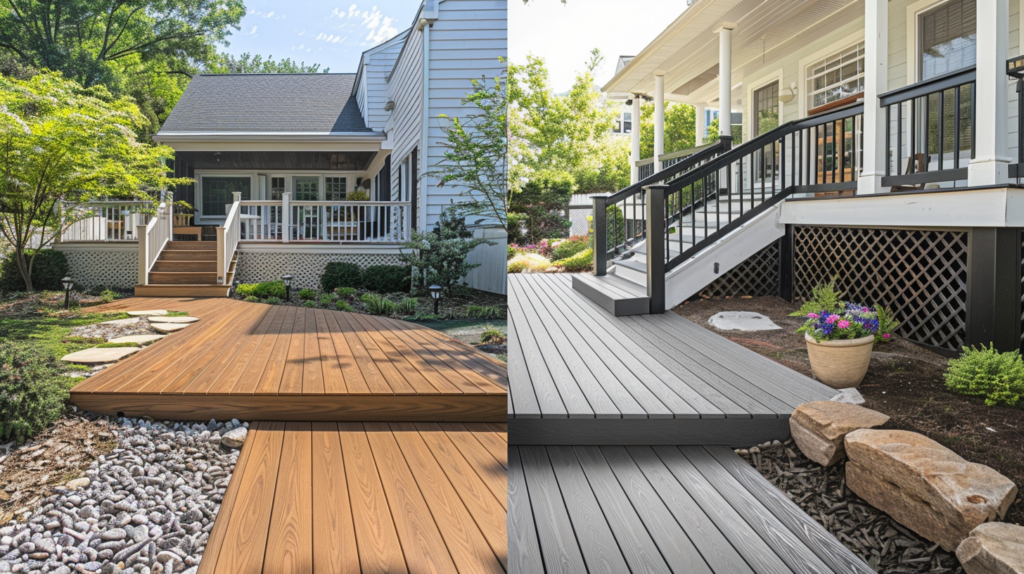
While composite decking may have a higher initial cost compared to traditional wood decking, it’s important to consider the long-term maintenance costs. With its durability and low maintenance requirements, composite decking can prove to be more cost-effective in the long run.
Let’s take a closer look at the cost comparison between composite deck boards and traditional wood decking.
Initial Investment
While the initial cost of composite decking materials can be higher than most traditional wood materials, it’s important to keep in mind the long-term savings. With composite decking, you’re not just buying a product; you’re investing in a solution that offers lasting value and reduces the need for constant maintenance.
Maintenance Costs
When considering the long-term costs, composite decking comes out on top. Over a decade, wood decking can lead to significantly higher maintenance expenses compared to the minimal upkeep required for composite decking. Routine maintenance for wood decks includes:
- Sanding
- Cleaning
- Staining
- Painting
- Sealing
All of these tasks need to be done every one to two years, which can add up over time.
But with composite decking, all you need is the occasional clean, saving you time and money in the long run.
Cost Calculator
To help you make an informed decision, online cost calculators can compare the costs of composite and wood decking over the deck’s lifespan. These calculators consider material types, per square foot of footage, and installation costs, providing a clear picture of the long-term investment.
Safety and Performance Features

When it comes to safety and performance, composite decking outshines traditional wood. Designed with traction in mind, composite decking often features textured or grooved surfaces to provide better grip. Some brands even incorporate technology to reduce heat absorption, providing a cooler surface in warm weather.
Let’s delve deeper into these features.
Slip Resistance
A common concern with decking is slipperiness, especially in wet conditions. However, manufacturers of composite decking have addressed this issue by incorporating textured surfaces and anti-slip coatings to enhance traction.
Some brands even engineer their composite decking for slip resistance, providing a safe and secure surface for your outdoor living space.
Heat Mitigating Technology
One advantage of composite decking is its ability to reduce heat absorption. Some brands, like Fiberon’s Transcend Lineage decking line, incorporate CoolDeck Technology, which can reduce heat absorption in wooden decks by up to 35%.
This means even on hot days, your deck remains cool and comfortable to walk on.
Fading and Stain Resistance
Composite decking has a secret weapon against the elements: a fade-resistant finish. This ensures that your deck maintains its color and aesthetic appeal over time without frequent staining or painting, yet another way composite decking outperforms traditional wood.
Customizing Your Outdoor Living Space
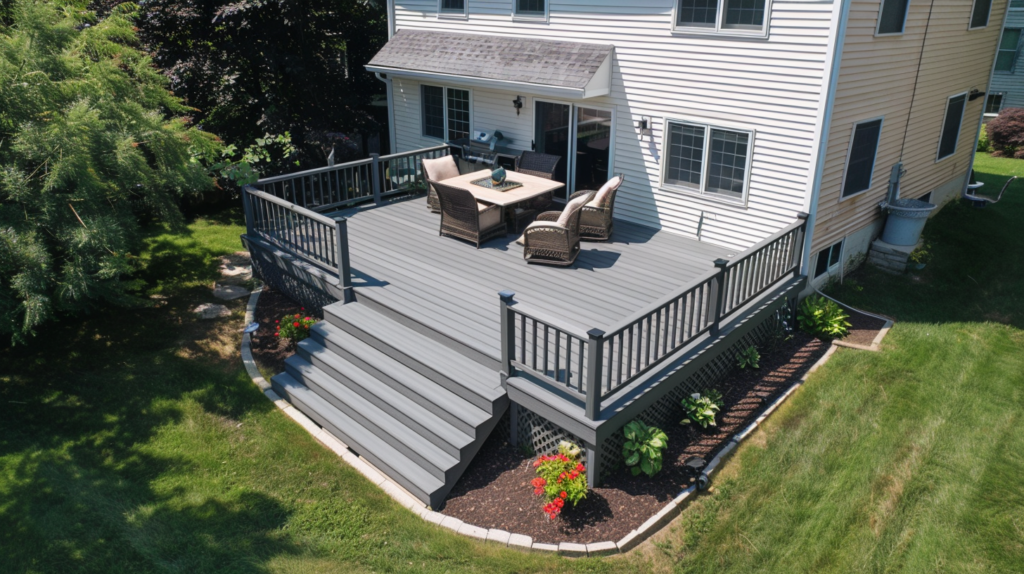
Composite decking isn’t just about durability and maintenance; it’s also about customization. With many colors and patterns, you can create a deck that complements your outdoor living space and reflects your style.
Let’s explore some of the options available.
Multi-Tonal Boards
One of the unique aspects of composite decking is the availability of multi-tonal boards. These boards feature a variety of colors and patterns, closely mimicking the look and feel of real wood.
Whether you’re looking for a traditional wooden look or a more modern aesthetic, there’s a multi-tonal board that’s perfect for you.
Lighter Color Options
If you’re looking to brighten up your outdoor living space, lighter-colored composite decking is a great option. Brands like TimberTech offer options in light tans and light grays, allowing you to customize your deck to your desired aesthetic.
Fastening Systems
When it comes to installing your composite decking, the right fastening system can make all the difference. Whether you prefer a seamless look with hidden fasteners or traditional top-down fasteners, there’s a system to suit your needs.
Ensuring consistent spacing and using the correct fasteners will ensure a secure and beautiful deck.
Environmental Impact of Composite Decking
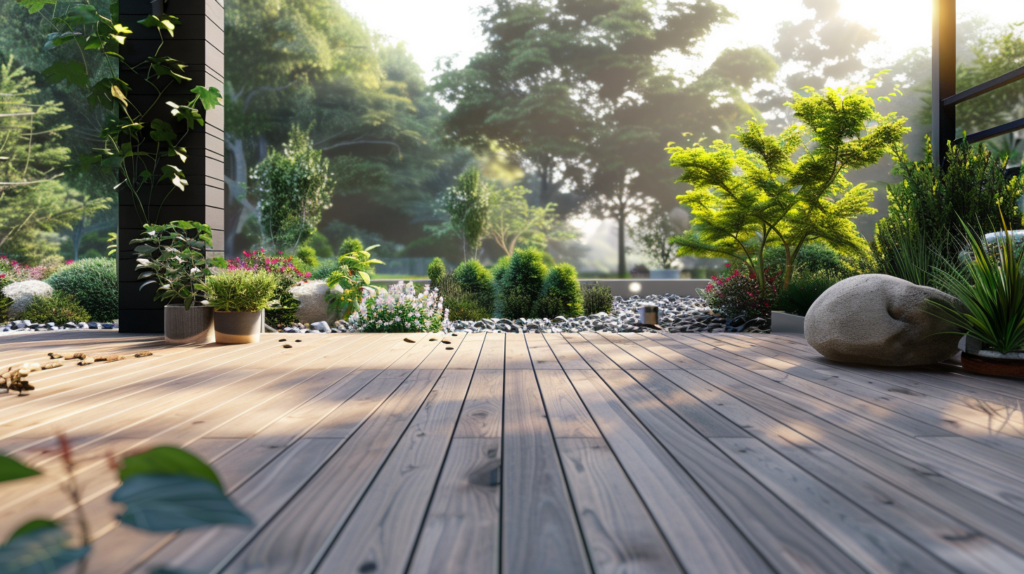
Composite decking isn’t just about aesthetics and durability; it’s also about sustainability. Composite decking is an environmentally responsible choice with a high percentage of recycled materials and eco-friendly manufacturing processes.
Let’s explore the environmental impact of composite decking in more detail.
Recycled Content
A key component of composite decking’s environmental friendliness is its use of recycled content. From plastic bags to milk jugs, a variety of post-consumer waste finds a new life in composite decking. This reduces landfill waste and makes composite decking a truly green choice.
Eco-Friendly Manufacturing
The manufacturing process of composite decking is also environmentally friendly. From reducing energy use to recycling water, composite decking manufacturers are committed to reducing their environmental impact.
Brands like Trex and TimberTech are leading the way with their sustainable manufacturing practices.
Common Myths About Composite Decking
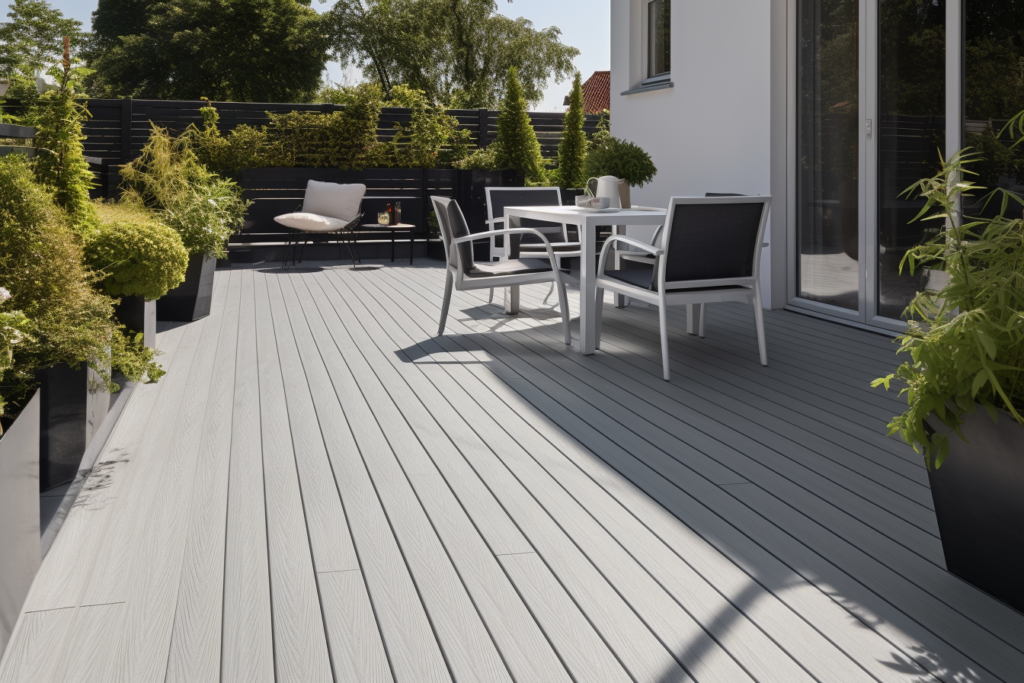
Like any innovative product, composite decking is often surrounded by myths and misconceptions. From concerns about slipperiness to doubts about its authenticity, let’s debunk some of the most common myths about composite decking.
Slippery Surfaces
One common myth is that composite decking is more slippery than other materials. However, this is not the case. In fact, composite decking manufacturers have taken great strides to enhance traction and minimize slipperiness. From textured surfaces to anti-slip coatings, composite decking is designed with safety in mind.
Authenticity
Another myth is that composite decking doesn’t look as authentic as real wood. However, with advances in manufacturing techniques, composite decking now closely mimics the look and feel of real wood. From subtle color blending to unique grain patterns, composite decking offers an authentic wood look that suits a variety of aesthetic preferences.
Structural Field Failures
There’s also a myth that composite decking is more prone to structural failures. In reality, quality composite decking materials are engineered for durability and longevity, significantly reducing the likelihood of structural failures if installed and maintained correctly.
Conclusion: Give Yourself Time to Find Your Best Option
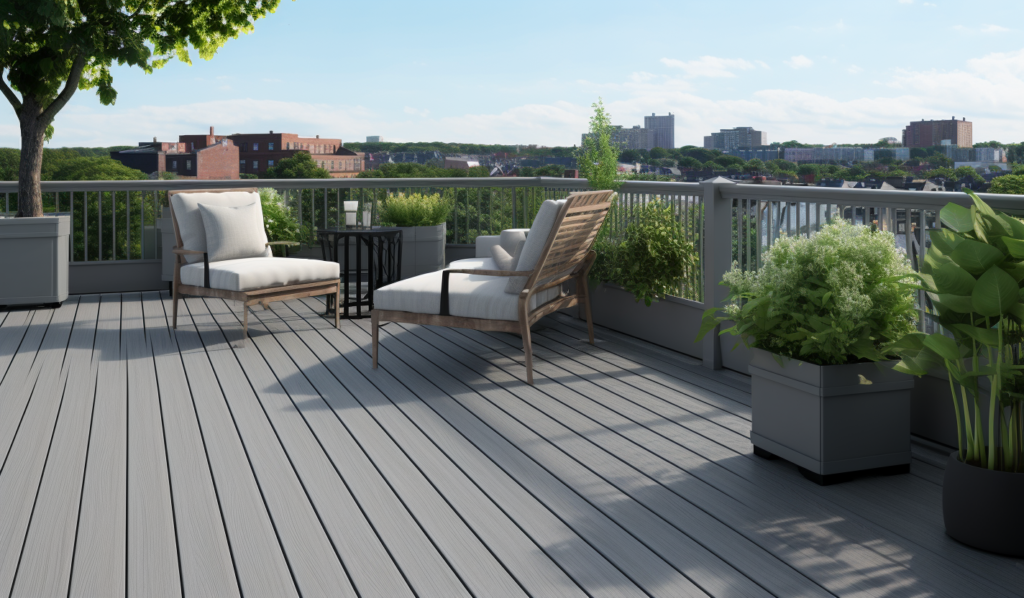
Composite boards are a great option for arranging an outdoor living space on a flat roof, porch, or garden in Massachusetts.
However, many surface materials options differ in weight, installation method, color, and resistance to various environmental factors. Are you interested in learning more about the differences between PVC and composite decking?
Don’t miss our upcoming article on PVC vs Composite Decking, where we’ll dive deep into the pros and cons of each material.
To avoid making a mistake with the choice, take the time to compare available offers and request samples of coatings from contractors. Consult with roofers and contractors. Experts will tell you which brand and model of coverage to choose for your living space requirements and budget. It is important to entrust the installation of the decks to professionals since not only the service life of the terrace boards depends on this, but also your comfort and safety.
In conclusion, composite decking offers many benefits over traditional wood decking. From its low maintenance and durability to its aesthetic appeal and eco-friendly manufacturing, composite decking is a superior choice for those looking to enhance their outdoor living space. So why wait? Take the plunge and transform your outdoor living space with composite decking today!
Frequently Asked Questions
Depending on the materials and labor involved, a 20 x 20 composite deck can cost between $8,000 and $20,000. Get ready to enhance your outdoor living space!
You should choose composite decking over traditional wood because it requires low maintenance, is highly durable, offers a variety of aesthetic options, and is eco-friendly. It’s a no-brainer!
Composite decking is made from recycled plastics, reclaimed wood, and synthetic materials to ensure durability and sustainability. Thus, it is an eco-friendly and durable choice for outdoor decking projects!
You should check out leading composite decking brands like Trex, TimberTech, Fiberon, and MoistureShield for top quality in 2024!
Composite decking offers fantastic safety and performance features, such as slip resistance, heat mitigating technology, and resistance to fading and staining, making it a great choice for your outdoor space!
Denis is the driving force behind ID Flat Roof, a leading company in Boston specializing in flat roof repair and installation for over 20 years.
Expertise:
Denis excels in PVC, TPO, EPDM, and rubber roofing. His meticulous approach ensures quality and customer satisfaction.
Innovation:
Denis incorporates cutting-edge solutions like skylights and solar PV roofing.



